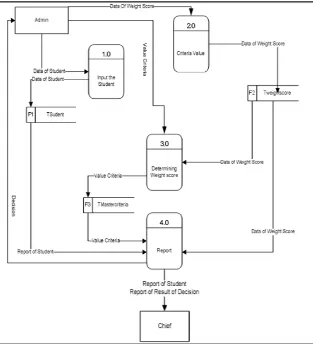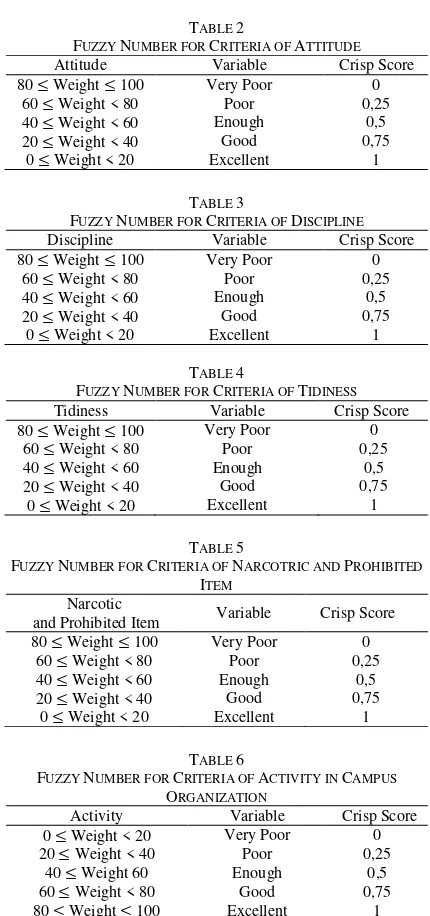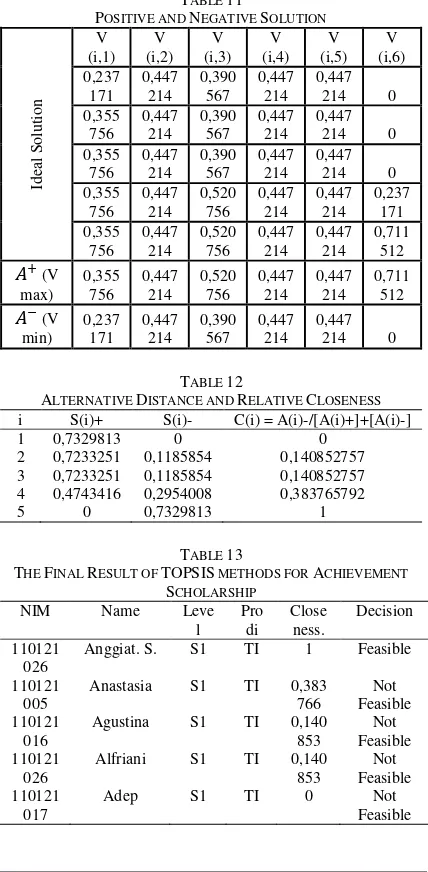75
Hoga Saragih, Murni Marbun, and Bobby Reza
1Fakultas Teknik dan Ilmu Komputer – Universitas Bakrie
Kampus Kuningan, Kawasan Epicentrum, Jl. H.R. Rasuna Said Kav. C-22 Jakarta 12920. 2Program Studi Teknik Informatika – STMIK Pelita Nusantara
Jl. Iskandar Muda No.1, Medan, Indonesia. 3Program Pasca Sarjana – STMIK Eresha
E-mail: [email protected], [email protected], [email protected]
Abstract
This research is the design of a decision support system (DSS) to determine the student as scholarship awardees of the STMIK Pelita Nusantara, Medan, Indonesia, with the approach of Fuzzy Multi Attribute Decision Making (FMADM) with TOPSIS method. The FMADM is implemented in the system by specifying the values of the weights for each of the criteria or attributes. Whilst, TOPSIS method is used for making the final decision of the scholarship awardees. Both methods are implemented in a decision support application system that indicates the interaction between users and the software interface. The application is designed by using Visual Basic 2008. This research formulates an application in selecting the scholarship awardee using Fuzzy Multi Attribute Decision Making (FMADM) approach and TOPSIS method. By using this application, the result and information related to determining the student who should be granted the scholarship can be done more quickly, rightly and accurately.
Keywords: Scholarship, Criteria, Selection, FMADM, TOPSIS, DSS
Abstrak
Penelitian ini mengenai desain sistem pendukung keputusan (DSS) untuk menentukan siswa sebagai penerima beasiswa dari STMIK Pelita Nusantara, Medan, Indonesia, dengan pendekatan Fuzzy multi Attribute Decision Making (FMADM) dengan metode TOPSIS. Pendekatan Fuzzy Multiple Attribute Decision Making (FMADM) dengan menentukan nilai bobot untuk masing-masing kriteria atau atribut dan metode TOPSIS untuk memilih penerima beasiswa mahasiswa. Penerapan sistem pendukung keputusan dapat menunjukkan interaksi pengguna dengan aplikasi perangkat lunak yang dibangun dengan menggunakan bahasa pemrograman Basic 2008 Visual. Kesimpulan hasil yang diperoleh dari diskusi menunjukkan bahwa pendekatan dengan FMADM TOPSIS memberikan hasil perhitungan akhir nilai memerintahkan yang dapat membantu pengambil keputusan menentukan siswa layak beasiswa. Adanya sistem pendukung keputusan yang telah dirancang sehingga proses penentuan penerima beasiswa mahasiswa lebih akurat, cepat, dan akurat.
Kata Kunci: Beasiswa, Kriteria, Pemilihan, FMADM, TOPSIS, DSS
1. Introduction
STMIK Pelita Nusantara Medan provides scholar-ship students who have high achievement and comi-ng from families with low economic level. The finan-cial of the scholarship is not a self fund or parents’ donation neither from the lecturer or researcher. The scholarship is supported by government, private co-mpany, embassy, and university. Scholarship is pro-vided to the right awardees based on classification, quality and competency of students.
This research is focus in designing a decision support system by Fuzzy Multi Attribute Decision Making (FMADM) approach using TOPSIS method. Once the FMADM approach gives a weight score for each criteria then TOPSIS method selects the awar-dee of scholarship. TOPSIS method applies principle that the chosen alternative must has a nearest distance from the positive ideal solution and far from the ne-gative ideal solution. The ranked alternatives must be references for decision maker to choose the best solu-tion. This method is applied in decision making prac-tically because its concept is quite simple and easy to understand, computationally efficient and is able to measure the relative performance from any decision alternatives [9].
Both methods are implemented in a decision su-pport application system that indicates the interaction between users and the software interface. The appli-cation is designed by using Visual Basic 2008. The Decision Support System (DSS) is defined as a sys-tem that supports a work of manager or group of
ma-nagers in solving semi structured problem by giving information or suggestion that lead to the decision [10].
2. Methodology
Figure 1 shows the flow chart of the support decision system in determining student as the scholarship aw-ardee using Fuzzy Multi Attribute Decision Making (FMADM) approach and TOPSIS method.
Fuzzy Multiple Attribute Decision Making (FMA-DM)
Fuzzy Multiple Attribute Decision Making (FMA-DM) is a method applied to obtain optimal alternative from any alternatives with certain criteria. The cont-ext of FMADM is determining the weight score for each attribute and followed by ranking process in se-lection of any alternatives. Principally, there are three approaches to determine the weight score of attribute,
i.e. subjective, objective, and integration between su-bjective and osu-bjective approaches. Each approach has advantages and disadvantages. On subjective ap-proach, the weight score is determined based on sub-jectivity of the decision maker so any factors in rank-ing process of alternatives can be determined inde-pendently. While in objective approach, the weight score is calculated mathematically that ignore subje-ctivity of the decision maker [9].
There are any method may be applied to solve the FMADM problem, such as: 1) Simple Additive Weighting (SAW); 2) Weighted Product (WP); 3) Electre; 4) Analytic Hierarchy Process (AHP); 5) Technique for Order Preference by Similarity to Ideal Solution (TOPSIS).
Technique for Order Preference by Similarity to Ideal Solution (TOPSIS)
TOPSIS was introduced by Yoon and Hwang in 1981 as one of methods to solve multi-criteria problems. TOPSIS gives a solution from given alternatives by comparing each alternative to the best and bad al-ternatives among the available solution options. This method applies distance to do the comparison. TOP-SIS method is developed based on the concept that search for the best alternative that not only has the shortest distance from the positive ideal solution but also has the longest distance from the negative ideal solution in geometric point of view by using Eucli-dean distance [3].
TOPSIS method ranks the alternatives based on relative nearest score priority of alternative to posi-tive ideal solution. The ranked alternaposi-tives become references to the decision maker in determining the best solution. This method is used to practically solve the decision making because its concept is simplest and easy to understand, its computation is efficient and can measure the relative performance of any de-cision alternatives. In the classic TOPSIS method, the weight score of each criterion is defined. Each weight score of criteria is defined based on its necessity level according to the decision maker.
The following is the procedure of TOPSIS me-thod:
Building a Decision Matrix
TOPSIS is begun by building a decision matrix. The decision matrix refers to alternatives that will be evaluated based on criteria. Decision matrix is given as equation (1) follows:
= ⋮ ⋮ ⋯⋱ ⋮
⋯ (1)
where ( = 1, 2, 3, … , ) is the set of possible al-ternatives, (j =1, 2, 3,…, n) is the set of attributes by which the alternative performances are measured with, is an alternative performance of by refer-ring to attribute .
Normalized Decision Matrix
Each element of the matrix is normalized to obtain the normalized matrix . Each normalized value can be calculated using the equation (2) as follows:
=
∑" ! #$
(2)
where = 1, 2, 3, . . . , ; and & = 1, 2, 3, . . . , ;
Weighted Normalized Matrix
The normalized matrix is t h e n weighted by ' =
(( , (), . . . , ( ). Thus, the weighted normalized
matrix * can be calculated using the equation (3) as follows:
+ = ( (3)
where = 1, 2, 3, . . . , ; and & = 1, 2, 3, . . . , ;
Determining the Ideal Solution.
Positive ideal solution ,- and ,.negative ideal solu-tion can be determined based on normalized weight-ed rating (/01) using the equation (4) and (5).
,-= 2+-, +)-, +3-, … , +-4 (4)
,.= 2+., +)., +3., … , +.4 (5)
Calculating Separation Measure
Separation measure is a measurement of the distance of an alternative to the positive and negative ideal solution. Mathematical calculation of the separation measurement to the positive ideal solution is shown by equation (6) while the separation measurement to the negative ideal solution is shown by equation (7).
5-= ∑ 6+ − +-8)
9 (6)
5.= ∑ 6+ − +.8)
where = 1,2,3, . . . ,
Calculating the Relative Closeness
In this step, the relative closeness of alternatives to the positive ideal is calculated. Relative closeness of the alternative ,-to ,. ideal solution calculated usi-ng equation (8):
:-= ;<
6;<- ;=8 , 0 ≤ :-≤ 1 (8)
where, = 1,2,3, . . . ,
Sorting Preference
Alternatives can be ranked based on the order of ,.The best alternative is the shortest to the positive solution and the longest to the ideal solution to the negative ideal solution. Alternative with the higher @- is a best solution.
FMADM Requirement Analysis
The problem-solving and computation of the scholar-ship awardee selection with TOPSIS method is des-cribed as the following phases.
Phase I
The number of alternatives and some of the attributes or criteria that will be used is defined in this phase. There are six criterion used as a basis for making decisions in the selection of scholarship awardee. Those are:
C1 = Grade Point Average (GPA) C2 = Attitude
C3 = discipline C4 = Tidiness
C5 = Narcotic and drugs
C6 = Activity in campus organization
Phase II
The criterion data is transformed into the crisp score by weighting each criteria as shown in the Table 1 to Table 6.
TABLE 1
FUZZY NUMBER FOR CRITERIA OF GPA
Score GPA Variable Crisp Score
0 ≤ GPA< 2,0 Very Poor 0
2,0 ≤ GPA < 2,5 Poor 0,25
2,5 ≤ GPA < 3,0 Enough 0,5
3,0 ≤ GPA < 3,5 Good 0,75
3,5 ≤ GPA ≤ 4,0 Excellent 1
TABLE 2
FUZZY NUMBER FOR CRITERIA OF ATTITUDE
Attitude Variable Crisp Score
80 ≤ Weight ≤ 100 Very Poor 0
60 ≤ Weight < 80 Poor 0,25
40 ≤ Weight < 60 Enough 0,5
20 ≤ Weight < 40 Good 0,75
0 ≤ Weight < 20 Excellent 1
TABLE 3
FUZZY NUMBER FOR CRITERIA OF DISCIPLINE
Discipline Variable Crisp Score
80 ≤ Weight ≤ 100 Very Poor 0
60 ≤ Weight < 80 Poor 0,25
40 ≤ Weight < 60 Enough 0,5
20 ≤ Weight < 40 Good 0,75
0 ≤ Weight < 20 Excellent 1
TABLE 4
FUZZY NUMBER FOR CRITERIA OF TIDINESS
Tidiness Variable Crisp Score
80 ≤ Weight ≤ 100 Very Poor 0
60 ≤ Weight < 80 Poor 0,25
40 ≤ Weight < 60 Enough 0,5
20 ≤ Weight < 40 Good 0,75
0 ≤ Weight < 20 Excellent 1
TABLE 5
FUZZY NUMBER FOR CRITERIA OF NARCOTRIC AND PROHIBITED
ITEM
Narcotic
and Prohibited Item Variable Crisp Score
80 ≤ Weight ≤ 100 Very Poor 0
60 ≤ Weight < 80 Poor 0,25
40 ≤ Weight < 60 Enough 0,5
20 ≤ Weight < 40 Good 0,75
0 ≤ Weight < 20 Excellent 1
TABLE 6
FUZZY NUMBER FOR CRITERIA OF ACTIVITY IN CAMPUS
ORGANIZATION
Activity Variable Crisp Score
0 ≤ Weight < 20 Very Poor 0
20 ≤ Weight < 40 Poor 0,25
40 ≤ Weight 60 Enough 0,5
60 ≤ Weight < 80 Good 0,75
80 ≤ Weight ≤ 100 Excellent 1
Phase III
The determination of the students who will be the scholarship awardees based on TOPSIS method is
undergone by considering the decision tables that each of which show the feasibility. The terms of feasibility is based on the final score as shown in the Table 7.
3. Results and Analysis
The data analysis in this research is based on the flow chart of FMADM using TOPSIS method whose fuz-zy score has been converted into crisp score as shown in the Table 8 by taking 5 (five) samples of student. To determine its decision matrix ( ), equation (9) is given. The normalization matrix ( ) is listed in Table 9. Whereas the normalized decision matrix is shown in Table 10.
alternative to the positive ideal solution (
:
-)
are as shown in Table 12. Whereas, the final
result of the scholarship awardee selection
using the TOPSIS methods are shown in
NORMALIZATION MATRIXR(i,1) R(i,2) R(i,3) R(i,4) R(i,5) R(i,6)
NORMALIZED DECISION MATRIX
NIM V
Figure 2 shows the application interface before entering the application. User login is required to use the program. In the login form, user is asked to input the username and password. If the username or password is not correct, it will not be proceeded to the next process. There are two types of user, i.e. admin and user. The difference between the roles is only admin is permitted to do the data imputation.
TABLE 11
POSITIVE AND NEGATIVE SOLUTION
Id
ALTERNATIVE DISTANCE AND RELATIVE CLOSENESS
i S(i)+ S(i)- C(i) = A(i)-/[A(i)+]+[A(i)-]
1 0,7329813 0 0
2 0,7233251 0,1185854 0,140852757
3 0,7233251 0,1185854 0,140852757
4 0,4743416 0,2954008 0,383765792
5 0 0,7329813 1
Figure 3 shows the interface of the main menu if login attempt is successfully executed. In the main menu, there are option of personal data form of can-didate, criteria score and decision making process.
Figure 4 shows the interface to enter the in-formation of student and the determined criterion. The information of student includes name and regis-tration number. The criterion input consist of 6 (six) determined attributes, i.e. GPA, weight of attitude, weight of discipline, weight of tidiness, weight of narcotic and prohibited items and weight of organi-zation activity.
Figure 5 shows the interface of TOPSIS calcu-lation process. Once the data of student and criteria of 6 (six) attributes is input as shown in Figure 3, the calculation involving fuzzy score to each criteria is executed.
Afterwards, the normalization matrix, weighted normalized matrix, the positive and negative ideal so-lution, the alternative distance and to display the re-sults of calculation using the TOPSIS method.
Figure 6 shows the interface of the report of the selected students as the scholarship awardees. The re-port consists of the student registration number, name and the education program. The report also displays the weight score of criteria and result of calculation by TOPSIS method of each criteria. The remark colu-mn shows whether the student is feasible or not as an awardee of the scholarship. Thus, it helps the chief as the final decision maker in giving the final decision of the scholarship awardee.
4. Conclusion
This research formulates an application in selecting the scholarship awardee using Fuzzy Multi Attribute Decision Making (FMADM) approach and TOPSIS method. By using this application, the result and
formation related to determining the student who should be granted the scholarship can be done more quickly, rightly and accurately. The result of this re-search indicates an implication that there is approach as a base to determine students as awardees of scho-larship i.e. Fuzzy Multi Attribute Decision Making (FMADM) with TOPSIS method.
References
[1] Ayu Gusti, Darma Gede, Wira B Putu. Multi-Attribyte Decision making Scholarship Selection Using A Modified Fuzzy TOPSIS. International Journal of Computer Science Issues (IJCSI) Vol.10 No.2, 2013.
[2] Ding, Ji-Feng. An Integrated Fuzzy Topsis Method For Ranking Alternatives And Its Application. Journal Of Marine Science and Technology, Vol 19, No 4, 2011.
[3] Sachdeva,. Multi-Factor Mode Critically Analysis Using TOPSIS. International Journal of Industrrial Engineering. Vol. 15 No. 3, 2009 [4] Kamran Shahanaghi, Sayed Ahmad Yazdian. Vendor Using A New Fuzzy Group TOPSIS Approach. Journal of Uncertain System Vol. 3 No. 3, 2009.
[5] K. Savita, DR. C. Chandrasekar. Network Se-lection Using TOPSIS in Vertical Handover Decision Schemes For Heterogeneous Wireless Network s. Intenational Journal of Computer Sciences Issues (IJCSI), Vol. 8 No. 2, 2011. [6] Pragati Jain and Manisha Jain. Fuzzy TOPSIS
Method In Job Sequencing Problems on Ma-chines of Unegual Efficiencies. Canadian Jour-nal on Computing in Mathematics, Natural Sci-ences, Engineering and Medicine. Vol. 2 No. 6, 2011.
[7] Shofwatul 'Uyun, Imam Riadi. A Fuzzy TOP-SIS Multiple-Attribute Decision Making for
Scholarship Selection. TELKOMNIKA, Vol. 9 No.1, 2011
[8] Gafur. Abdul. (2008). Cara Mudah Mendapat-kan beasiswa. Jakarta, Indonesia. Penebar Plus Publisher.
[9] Kusumadewi, S., Hartati, S., Harjoko, A., War-doyo, R. Fuzzy Multi Attribute Decison making (FUZZY MADM), Graha Ilmu, Yogyakarta, 2006.
[10] Julius Hermawan. Membangun Decision Sup-port System, Andi, Yogyakarta, 2005.
[11] Hasan, M. Iqbal. Pokok-Pokok Materi Tori Pe-ngambilan Keputusan. Bogor: Ghalia Indone-sia, 2004.
[12] Kusumadewi S dan Purnomo H. Aplikasi Logi-ka Fuzzy untuk Pendukung Keputusan. Yogya-karta: Graha Ilmu. 2004.
[13] Marimin. Teknik dan Aplikasi Pengambilan Keputusan Kriteria Majemuk. Grasindo. Ja-karta, 2004.
[14] Pedoman Umum Beasiswa dan Bantuan Biaya Pendidikan Peningkatan Prestasi Akademik, Direktorat Pembelajaran dan Kemahasiswaan Direktorat Jenderal Pendidikan Tinggi, 2013. [15] Surbakti, Irfan, Sistem Pendukung Keputusan
(Decision Support System). Jurusan teknik In-formatika Fakultas Teknologi Informasi Institut Teknologi Sepuluh November. Surabaya, 2002. [16] Turban, Efraim Aronson, Jay E, and lang, Ting Peng Decision Siupport System an Intelegence System. Penerbit ANDI, 2001
[17] Turban, Efraim Aronson, Jay E, and lang, Ting Peng Decision Siupport System an Intelegence System. 7th Edition, Jilid 1, Penerbit ANDI. Yogyakarta, 2005.



